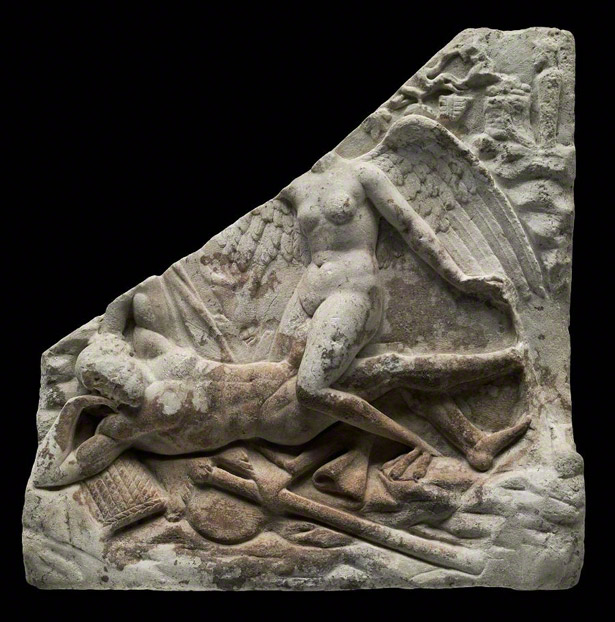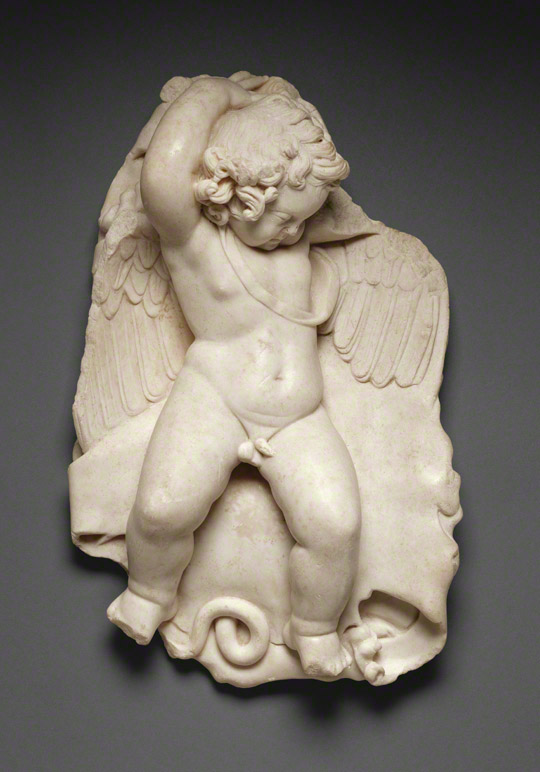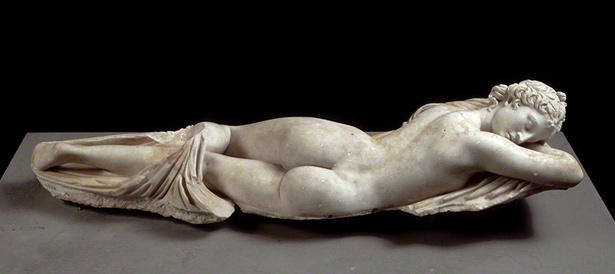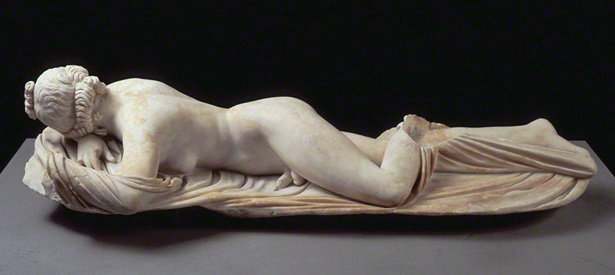
Relief with a Man and a Siren, Roman, A.D. 1–200. Marble, 15 7/8 x 15 3/4 x 4 in. Museum of Fine Arts, Boston. Gift of Fiske Warren and Edward Perry Warren
One of the most enjoyable aspects of curating an exhibition is serendipity. Not to say these projects aren’t carefully planned (far from it), but sometimes the physical relationship of two artworks will coincide in an unexpectedly fortuitous way, or a view through a doorway will work especially well. And sometimes an entirely other theme will rise to prominence through juxtapositions of different objects. That’s the case in our “Aphrodite in Myth” gallery in Aphrodite and the Gods of Love, where sleep is a recurrent motif.
First, perhaps, you’ll be drawn to the object shown above, an unusual stone relief of a man—mature to judge by what remains of his beard—lying sprawled outdoors. His belongings are scattered beside him, and he seems to be just waking from sleep, or at least somewhat restless. Hardly a surprise, given that he’s straddled by a female figure. Is this the realization of a fantasy, the coming-true of our male traveler’s dreams? Perhaps, but this isn’t anything like the mythical tale of Pygmalion, who carved a female figure that he loved so much that she came to life. This woman is winged, for one thing, so there’s something supernatural going on. To make things really weird, she’s also got webbed feet…
A winged web-footed woman: this must be a siren, a figure best known from the episode in The Odyssey in which the sirens were reputed to seduce sailors to their death with their lovely song. (Odysseus cleverly resisted by putting wax in his sailors’ ears and having himself tied to the mast.)
The link between sirens and death recurs in Greek art, and they are often found in funerary contexts. On this relief, the siren resorts not to song, but to a physical attack, dominating the male traveler with her magnificent body—perhaps with a little help from the potion she seems to be pouring from a cup in her hand. All of which makes this scene look less like a fantasy and more like a nightmarish vision combining sleep, sex, and death.
Turning away from this relief in the exhibition gallery, there lies a little recumbent Eros. He seems much sweeter, and we can look at this sleeper without worrying about any freakish goings-on. This statue has been in storage for a number of years, and the Aphrodite exhibition has been a great opportunity to bring him out on display; he seems to draw glances of motherly and fatherly affection from everyone who sees him.

Statuette of a Sleeping Eros, Roman, A.D. 50–100. Marble, 5 5/16 x 16 1/2 x 10 1/4 in. The J. Paul Getty Museum, 73.AA.95
But though he evokes parental sentiments, is he really as vulnerable and exposed as he appears? Look closely and you’ll see the strap of his quiver. Eros’s arrows know no resistance, and if anyone is vulnerable when it comes to Eros, it’s us. Making the point more clearly is the object he sleeps upon: a lionskin, evoking his Herakles-like strength. Eros might be asleep now, but it may be best not to wake him. Who knows what sort of trouble he might cause?
So instead we creep away, attentions drawn by the delicious figure of the Sleeping Hermaphrodite. This is an exquisite Roman sculpture; look at how the restless movement of the foot stretches fabric taut around it. The naked buttocks, the swell of the hip, all that exposed flesh…this is a figure rich with feminine allure.

Hermaphroditos (The Sleeping Hermaphrodite), Roman, A.D. 100–200. Marble, 59 1/16 in. long. Museo Nazionale Romano. Su concessione del Ministero per i Beni e le Attività Culturali – Soprintendenza Speciale per i Beni Archeologici di Roma
Seduced, we move nearer, and see that the figure is sleeping, which—even though we know it’s only stone—emboldens us to look closer still, to peer around, and to see what else might be on display on the other side. Walking around the head, our expectations continue to be met: yet more naked flesh, and then…a penis. Things have become decidedly unsettling once again. Is this a man or a woman? Is the sight of this nearly naked figure still such a turn-on? Would it have been better if we hadn’t been seduced by this sleeper’s exposed body, and contented ourselves with the delights of our first glances?

All of which goes to show that there can be a fine line between fantasy and nightmare, pleasure and repulsion, vulnerability and power, even male and female. Most of all, perhaps, it’s the relationship between viewer and viewed that’s most thrilling. Our reactions can be as crucial to an artwork’s purpose as, for example, the quality of its carving. These three sleepers compel us to consider how we become active participants whenever we engage with art.

Gazing: In the galleries of Aphrodite and the Gods of Love with Statuette of a Sleeping Eros




I’ve always enjoyed the remarkable Classical collection of the Getty. Never noticed the webbed feet on the seducing maiden – always took her to be an angel, but now that you point out what she really seems to be doing, it doesn’t come across as angelic at all! If she is a siren, then it seems like the man she is seducing is trying to cover his ears – but too late (unlike wise Odysseus). Thanks for highlighting these three sculptures.